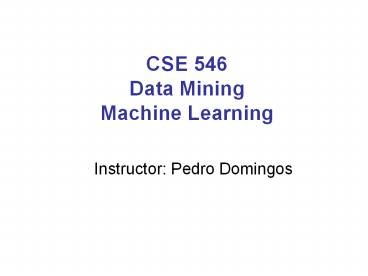CSE 546 Data Mining Machine Learning - PowerPoint PPT Presentation
Title:
CSE 546 Data Mining Machine Learning
Description:
CSE 546 Data Mining Machine Learning Instructor: Pedro Domingos Logistics Instructor: Pedro Domingos Email: pedrod_at_cs Office: CSE 648 Office hours: Wednesdays 3:30-4 ... – PowerPoint PPT presentation
Number of Views:147
Avg rating:3.0/5.0
Title: CSE 546 Data Mining Machine Learning
1
CSE 546Data MiningMachine Learning
- Instructor Pedro Domingos
2
Logistics
- Instructor Pedro Domingos
- Email pedrod_at_cs
- Office CSE 648
- Office hours Wednesdays 330-420
- TA Hoifung Poon
- Email hoifung_at_cs
- Office 220
- Office hours Mondays 130-220
- Web www.cs.washington.edu/546
- Mailing list cse546_at_cs
3
Evaluation
- Four homeworks (15 each)
- Handed out on weeks 1, 3, 5 and 7
- Due two weeks later
- Some programming, some exercises
- Final (40)
4
Source Materials
- R. Duda, P. Hart D. Stork, Pattern
Classification (2nd ed.), Wiley (Required) - T. Mitchell, Machine Learning,McGraw-Hill
(Recommended) - Papers
5
A Few Quotes
- A breakthrough in machine learning would be
worthten Microsofts (Bill Gates, Chairman,
Microsoft) - Machine learning is the next Internet (Tony
Tether, Director, DARPA) - Machine learning is the hot new thing (John
Hennessy, President, Stanford) - Web rankings today are mostly a matter of
machine learning (Prabhakar Raghavan, Dir.
Research, Yahoo) - Machine learning is going to result in a real
revolution (Greg Papadopoulos, CTO, Sun) - Machine learning is todays discontinuity
(Jerry Yang, CEO, Yahoo)
6
So What Is Machine Learning?
- Automating automation
- Getting computers to program themselves
- Writing software is the bottleneck
- Let the data do the work instead!
7
- Traditional Programming
- Machine Learning
Computer
Data
Output
Program
Computer
Data
Program
Output
8
Magic?
- No, more like gardening
- Seeds Algorithms
- Nutrients Data
- Gardener You
- Plants Programs
9
Sample Applications
- Web search
- Computational biology
- Finance
- E-commerce
- Space exploration
- Robotics
- Information extraction
- Social networks
- Debugging
- Your favorite area
10
ML in a Nutshell
- Tens of thousands of machine learning algorithms
- Hundreds new every year
- Every machine learning algorithm has three
components - Representation
- Evaluation
- Optimization
11
Representation
- Decision trees
- Sets of rules / Logic programs
- Instances
- Graphical models (Bayes/Markov nets)
- Neural networks
- Support vector machines
- Model ensembles
- Etc.
12
Evaluation
- Accuracy
- Precision and recall
- Squared error
- Likelihood
- Posterior probability
- Cost / Utility
- Margin
- Entropy
- K-L divergence
- Etc.
13
Optimization
- Combinatorial optimization
- E.g. Greedy search
- Convex optimization
- E.g. Gradient descent
- Constrained optimization
- E.g. Linear programming
14
Types of Learning
- Supervised (inductive) learning
- Training data includes desired outputs
- Unsupervised learning
- Training data does not include desired outputs
- Semi-supervised learning
- Training data includes a few desired outputs
- Reinforcement learning
- Rewards from sequence of actions
15
Inductive Learning
- Given examples of a function (X, F(X))
- Predict function F(X) for new examples X
- Discrete F(X) Classification
- Continuous F(X) Regression
- F(X) Probability(X) Probability estimation
16
What Well Cover
- Supervised learning
- Decision tree induction
- Rule induction
- Instance-based learning
- Bayesian learning
- Neural networks
- Support vector machines
- Model ensembles
- Learning theory
- Unsupervised learning
- Clustering
- Dimensionality reduction
17
ML in Practice
- Understanding domain, prior knowledge, and goals
- Data integration, selection, cleaning,pre-process
ing, etc. - Learning models
- Interpreting results
- Consolidating and deploying discovered knowledge
- Loop































